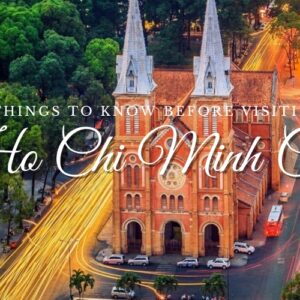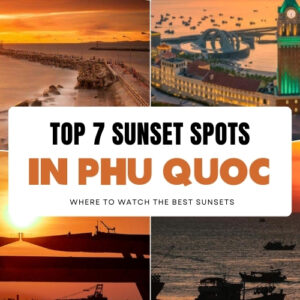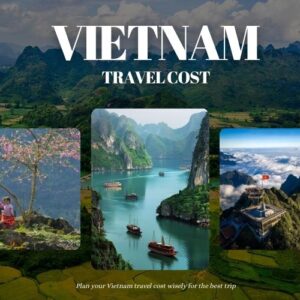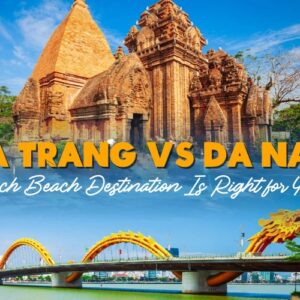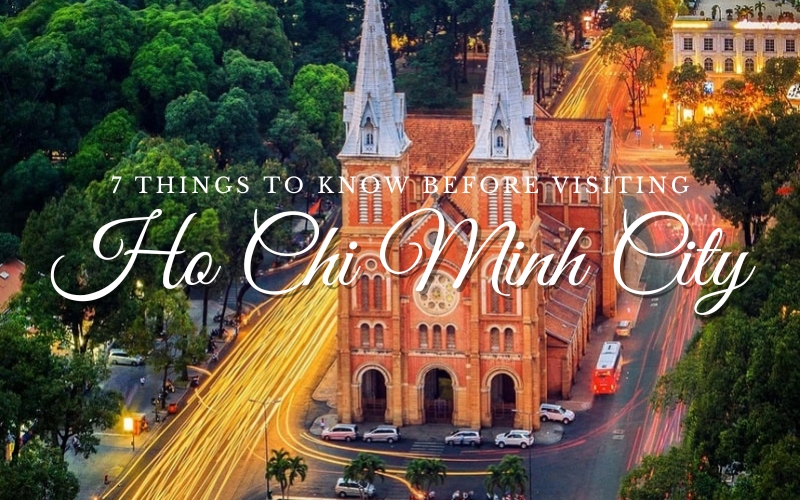
Ho Chi Minh City, formerly known as Saigon, is a vibrant metropolis that seamlessly blends rich history, modern energy and unique cultural charm. However, to get the most out of your trip, preparation is essential. This guide covers the essential things to know before visiting Ho Chi Minh City, helping you avoid common pitfalls and ensuring a smooth, enjoyable experience in Vietnam’s largest and most vibrant city.
General Weather and What to Pack for Your Trip
Ho Chi Minh City has a tropical monsoon climate with two distinct seasons: dry season and rainy season. The dry season from December to April is the best time to travel to the city. During this time, the weather is dry and sunny, with temperatures ranging from 25°C to 35°C (77°F to 95°F), very suitable for outdoor activities such as sightseeing, culinary experiences, shopping, etc.
This time of year also has many festivals such as Lunar New Year, New Year’s Eve, Christmas, …, helping you to learn more about the culture and local people. However, this is also the peak tourist season, so the number of tourists is very large and hotel service prices will also be higher. You should book in advance to make your trip smoother.
The rainy season from May to October is generally hotter and more humid, with short afternoon showers. Therefore, you can still visit and explore in the morning or evening. When preparing for your trip, bring light and breathable clothing to suit the weather here. Don’t forget to bring sun protection, such as sunscreen, a wide-brimmed hat and sunglasses, as the sun can be quite strong, especially in the middle of the day. If you visit during the rainy season, a compact umbrella or light raincoat will be extremely useful to keep you dry during sudden showers.
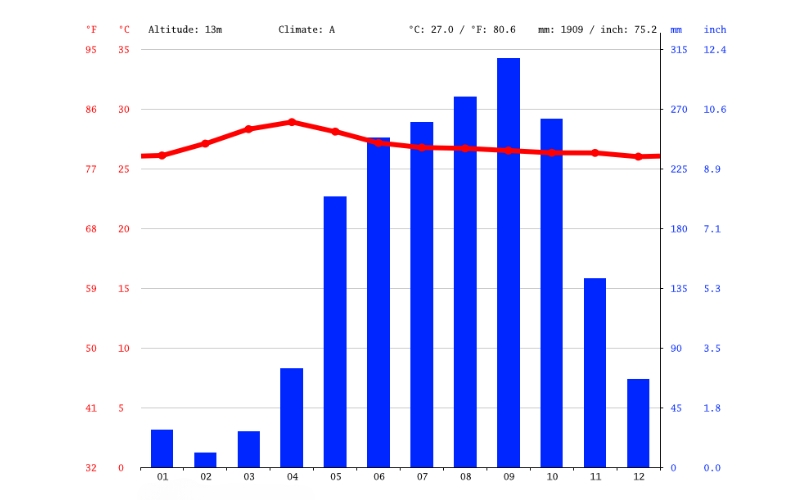
Ho Chi Minh City Weather
Currency and Payment
The official currency of Vietnam is the Vietnamese Dong (VND). Many restaurants, hotels, shopping malls, and shops near major tourist areas may accept payments in dollars, bank transfers, or visa cards. However, most local markets, street vendors, and small shops only accept cash in VND. For convenience and safety, carry cash to pay for everyday expenses such as food, taxis, etc. You can easily exchange cash at ATMs throughout the city or at banks. Additionally, digital payment platforms such as MoMo and ZaloPay are becoming increasingly popular in Vietnam, but they may require a local bank account or mobile phone number to register.
Transportation
Getting around Ho Chi Minh City can be both exciting and challenging, with its busy streets and dynamic traffic. To ensure a smooth experience, it is essential to understand the city’s transportation options and etiquette.
- One of the most convenient and reliable ways to get around is to use Grab, a ride-hailing app similar to Uber. Grab offers car and motorbike services, offering flexibility based on your budget and preferences. This is a great option for short trips within the city or to visit specific attractions without having to worry about negotiating a fare. Taxis are also common, but it is recommended to use reputable companies such as Mai Linh or Xanh SM, as they operate metered taxis that ensure reasonable prices. Avoid unmarked taxis, as they can charge high prices.
- If you are feeling adventurous, renting a motorbike is a popular way to explore the city like a local. However, traffic in Ho Chi Minh City can be very crowded, especially for inexperienced drivers. If you choose this option, make sure you have an international driving license, wear a helmet, and familiarize yourself with local traffic rules.
- For short distances, walking can be a fun way to soak up the city’s vibrant atmosphere, and you can also explore many hidden aspects of the city. However, crossing the street can be intimidating due to the constant flow of traffic.
- There are public buses, but they can be confusing for non-Vietnamese visitors as routes and stops are not always clearly marked. For more detailed exploration, consider the hop-on-hop-off double-decker buses that take you to major landmarks with ease.
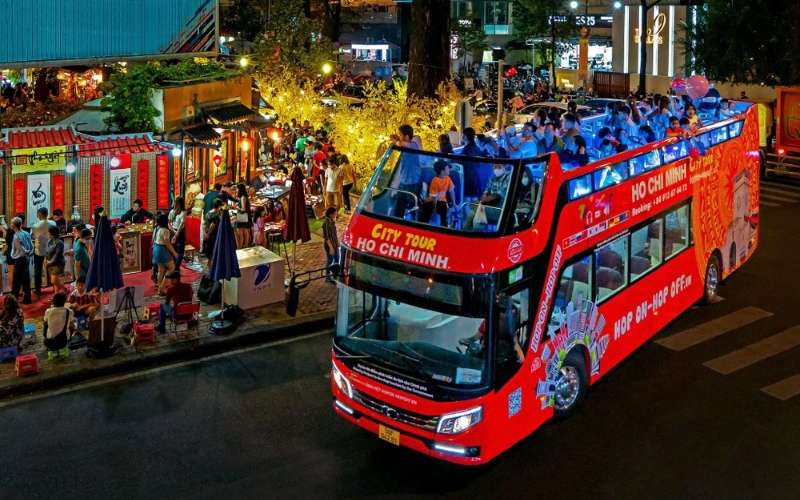
Hop on Hop Off double-decker bus tour around the city
>>> >>> Experience the perfect blend of vibrant city life and tranquil countryside as you journey through the heart of Saigon and the serene Mekong Delta in just 5 unforgettable days.
Unique and Attractive culture
Cultural Exchange
The city’s long history and strong colonial influences create a unique cultural exchange between the West and the East. Iconic structures such as Notre Dame Cathedral, Saigon Central Post Office and Independence Palace all have a combination of Western and traditional Vietnamese architecture. Walking through the central streets, visitors can clearly feel the interweaving of skyscrapers and streets with strong historical imprints. Chinatown in District 5 is a living testament to the city’s cultural diversity, where you can admire ancient pagodas, traditional Chinese festivals and enjoy typical dishes such as noodles, dim sum, …
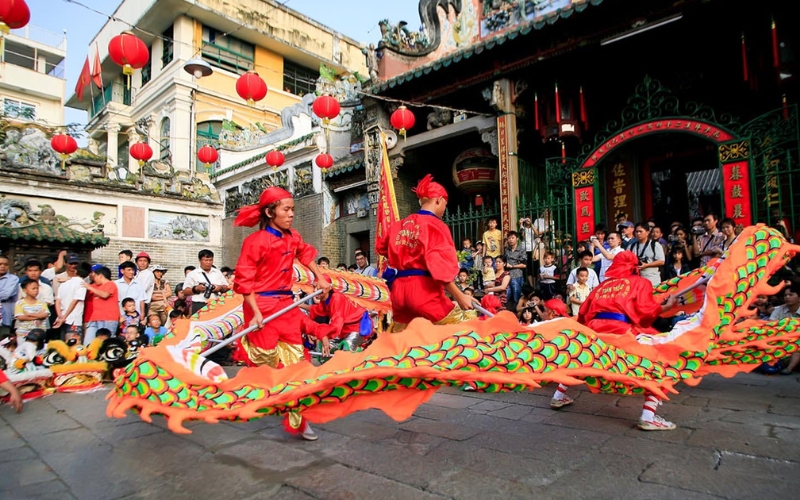
Chinatown in Ho Chi Minh City
Street food—the soul of Ho Chi Minh City
Simple dishes with rich flavors such as pho, banh mi, com tam, and hu tieu are sold on every street corner, from sidewalk eateries to bustling markets such as Ben Thanh Market and Tan Dinh Market.
What is special about Saigon cuisine is the combination of regional flavors. Visitors can find typical dishes from the North, Central, South, and even dishes with international flavors. Enjoying a dinner on the sidewalk with the vibrant atmosphere, the cries of vendors, and the street lights will bring an extremely intimate and interesting experience.
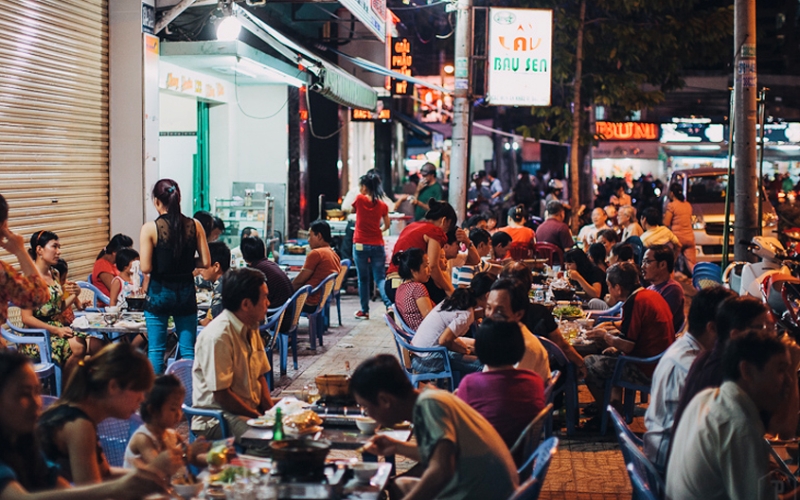
a crowded sidewalk eatery in Saigon
Dynamic Life
Saigon is known as the “city that never sleeps” because of its vibrant life from morning to night. Areas such as Nguyen Hue Walking Street or Bui Vien Western Street are the bustling centers of the city. These places gather bars, restaurants, and nightlife activities, attracting a large number of young people and foreign tourists. In addition, on festivals such as Lunar New Year, the city also organizes major events with art performances, flower festivals, and brilliant fireworks, creating a vibrant but meaningful festival atmosphere.
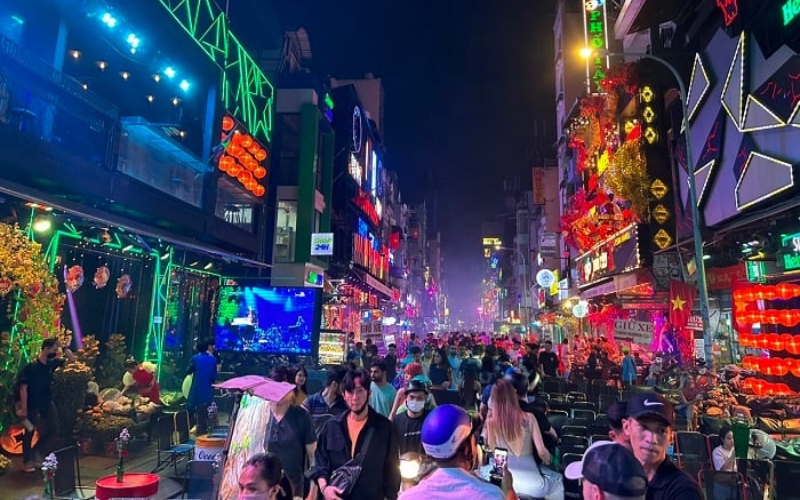
the bustling Bui Vien Street
>>> As the sun sets, Ho Chi Minh City transforms into a lively playground of lights, music, and endless entertainment, let’s experience the bustling nightlife you won’t forget.
Hospitable and Friendly Saigon
One of the most outstanding features of Saigon is its people. The openness, friendliness, and willingness to help of the people make anyone who comes here feel warm. Whether they are street vendors or coffee shop owners, they always bring a sense of closeness and sincerity, creating an unforgettable impression in the hearts of visitors.
Main attractions in Ho Chi Minh City
Reunification Palace
Independence Palace, also known as Reunification Palace, is a building built by the French during the colonial period. With Vietnamese, Independence Palace is a historical relic that symbolizes peace and territorial integrity. It was recognized as one of the 10 special national relics of Vietnam in 2009. This place displays and preserves valuable images and artifacts from the 19th century according to different themes. In particular, it still retains the interior of important rooms such as the reception room, cabinet room,…
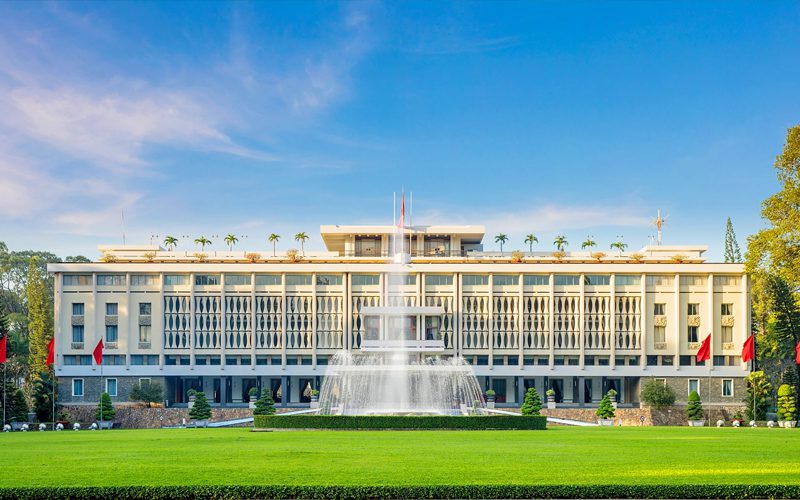
Independence Palace – Ho Chi Minh City
Ben Thanh Market
Ben Thanh Market is one of the most famous symbols of Saigon. This is a bustling market with a history of hundreds of years. Ben Thanh Market sells all kinds of goods from food, fabrics, clothes, household items, Saigon specialties,… and importantly, the extremely attractive food court in the market and the impressive check-in corners will make you always want to stay here for a long time. Bargaining is part of the fun here, so don’t hesitate to haggle for a good deal.
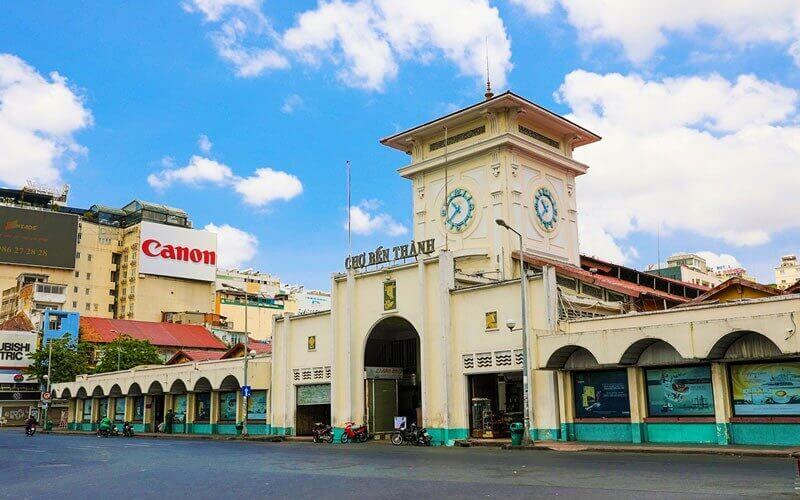
Ben Thanh Market
Cu Chi Tunnels
Cu Chi Tunnels is a historical site located in the suburbs, about 70 km from the center of Ho Chi Minh City. This is one of the favorite tourist attractions in Saigon, especially for foreign tourists. This is also a special national relic, associated with the history of the Vietnam War, once an important base and also a common living place of the army during the resistance war. In addition, inside the Cu Chi Tunnels, their lives are also recreated through realistic models and objects. Visitors can crawl through a section of the tunnel to experience the conditions that the soldiers faced or join guided tours to better understand and have a fascinating look at wartime.
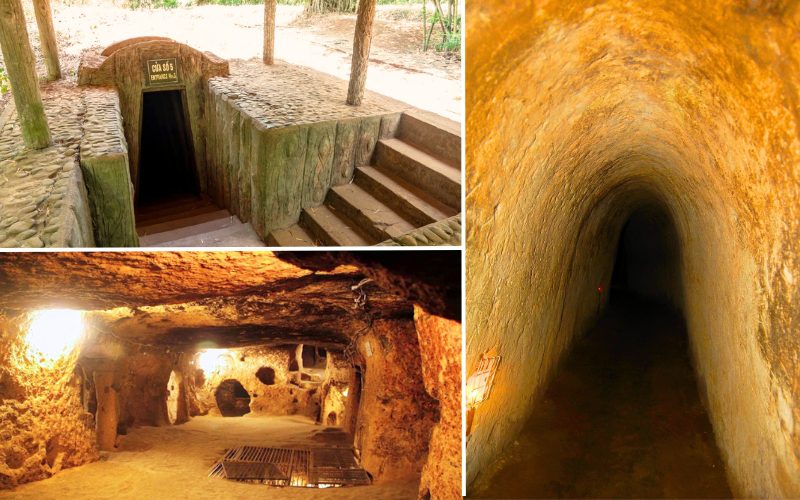
Inside Cu Chi Tunnel
Notre-Dame Cathedral Basilica of Saigon
Also located in the heart of District 1, Notre Dame Cathedral is a must-see tourist destination in Ho Chi Minh City. Built from 1863 to 1880 by French colonists, this church is a testament to the city’s colonial past. Notre Dame Cathedral is a unique architectural work with a strong European style, a place of living and holding mass for Catholics in Saigon. When visiting Notre Dame Cathedral, you can come in the morning to fully admire the beauty of the church in daylight, check in at every corner of the Gothic-style church,… especially the church always welcomes visitors, locals and anyone coming here to listen to sermons.
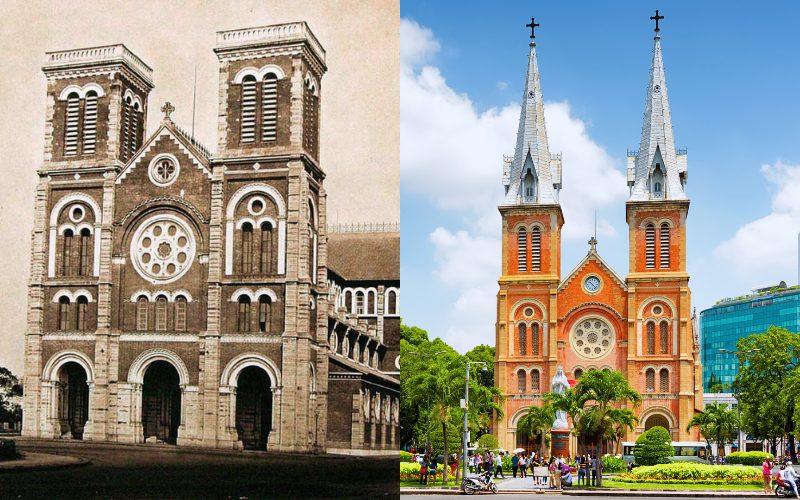
Notre Dame Cathedral of Saigon Then vs. Now
Bitexco Tower
Bitexco Financial Tower, one of the tallest buildings in Ho Chi Minh City, is a symbol of the city’s new development. The building’s Skydeck, located on the 49th floor, offers breathtaking panoramic views of the sprawling city, the Saigon River and beyond. Visitors can also enjoy a drink or meal at one of the building’s fine restaurants and bars for an unforgettable experience.
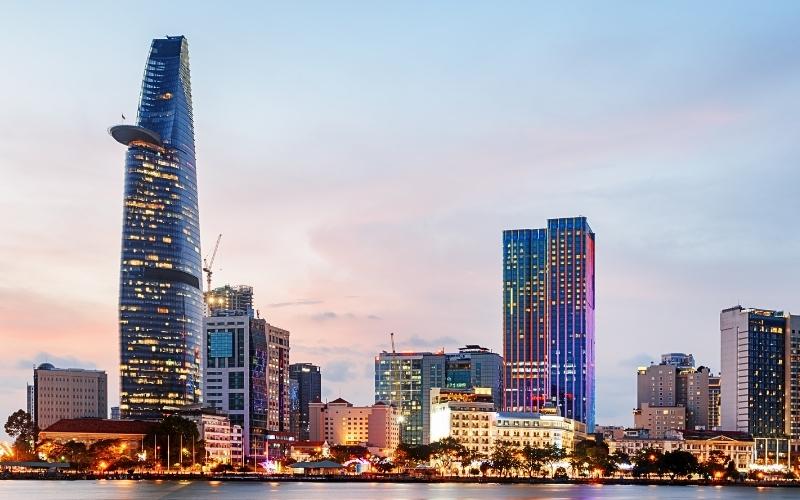
A View of Bitexco Financial Tower from afar
>>> Discover the rich history and vibrant culture of Ho Chi Minh City with this 5-day tour, taking you through its iconic landmarks, colonial architecture, and hidden cultural gems.
Must-try dishes when visiting Ho Chi Minh City
Banh Mi
Banh mi is a familiar and familiar dish to all Vietnamese people. The wonderful flavor of banh mi is a combination of cold cuts, spring rolls, sausages, pate, pickles, onions, coriander… and a very special sauce. Not only that, today, banh mi is also combined with roasted meat, meatballs, fish cakes,… Every bite offers a perfect balance of tangy, savory, and spicy flavors. You can easily see banh mi shops or carts everywhere in the city. Banh Mi Huynh Hoa and Hoa Ma are among the most famous places to enjoy this dish.
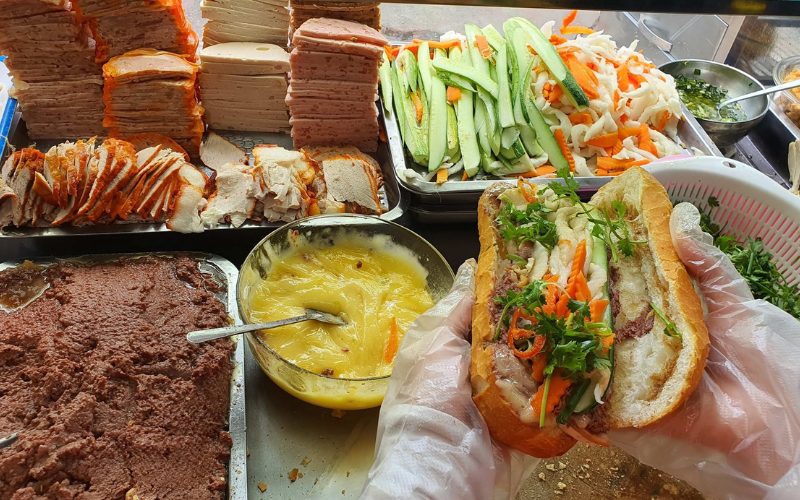
Banh Mi
Com Tam
Broken rice is a specialty of the city that anyone who comes here must try at least once. Broken rice consists of broken rice grains served with grilled pork ribs (ribs), fried eggs, shredded pork skin and pickled vegetables. The dish is enhanced with a little sweet fish sauce and is usually served with a small bowl of soup. In the past, broken rice was only for poor workers because the price of broken rice was cheaper than regular rice. But now, thanks to the combination of unique flavors and delicious dipping sauce, broken rice has become a specialty of bustling Saigon that everyone loves.
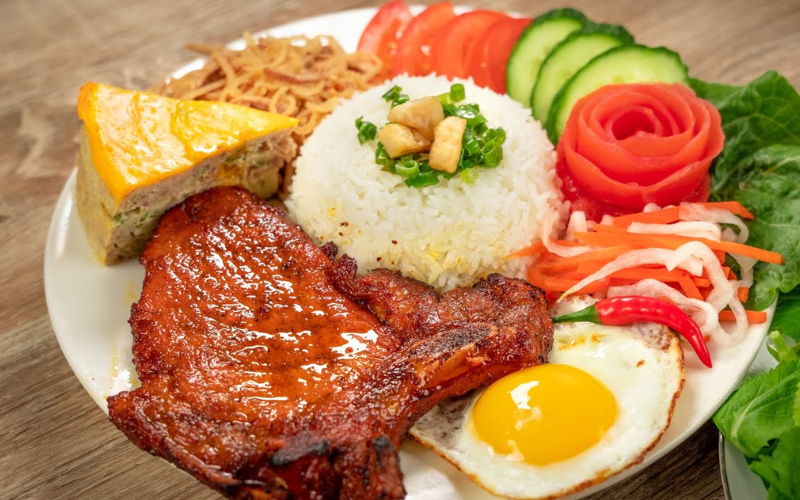
Com Tam – Broken rice
Hu Tieu
Hu Tieu is a familiar dish of the people in the South, and the variety in cooking Hu Tieu is what makes the flavor different in each place. Hu Tieu is a diverse noodle dish with two variations: dry (served with broth) or soup. The broth is clear, light but rich, usually made from pork bones and seafood. Toppings include slices of pork, shrimp, squid and sometimes quail eggs. This dish is often garnished with chives, fried onions and lemon.
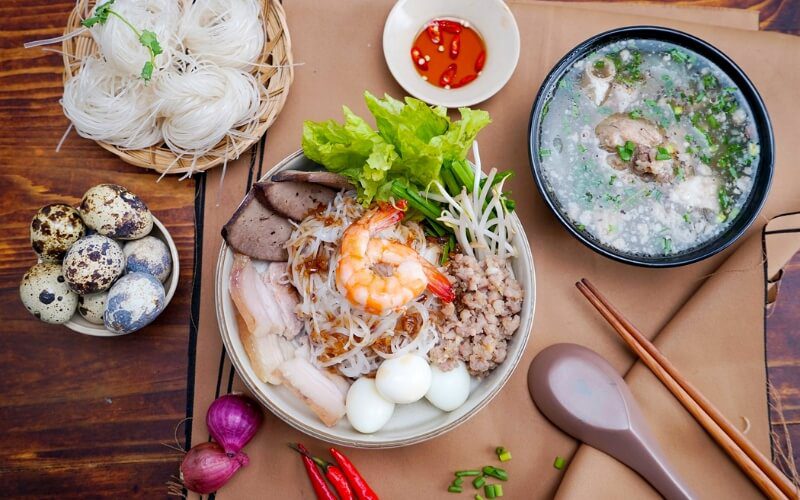
Hu Tieu
Pha Lau
Pha Lau has become a specialty of Saigon because of the process of processing, creating and transforming the internal organs of animals into an extremely delicious and flavorful dish. To make a delicious Pha Lau without any smell, the chef must prepare it very carefully, marinate the spices skillfully to cover the smell of the internal organs. Not only that, the flavor of the broth is equally important to create this dish.
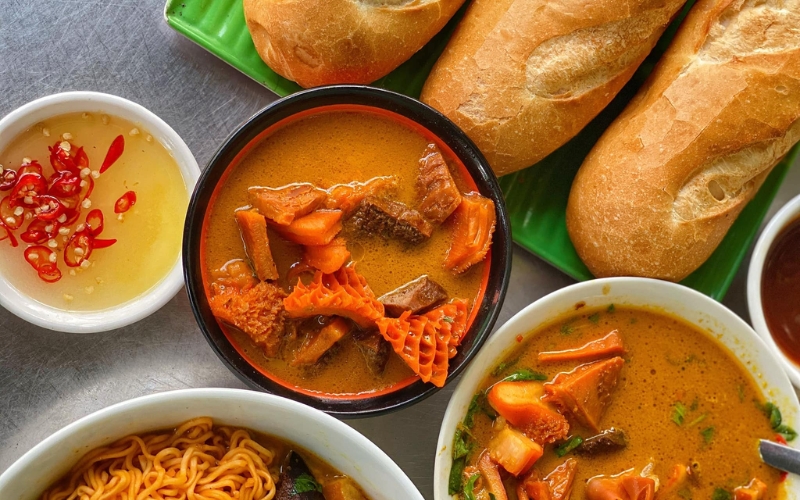
Pha Lau
Dumplings
Dumplings, also known as Vietnamese dumplings, is a must-try for those who enjoy delicate, flavorful bites. These dumplings are influenced by Chinese cuisine and are typically filled with minced pork, shrimp, wood ear mushrooms, and scallions. They can be steamed, boiled, or fried, and are often served in a light, rich broth or as part of a noodle soup. Their soft skin and juicy filling make them an irresistible comfort food. For an authentic experience, head to Chinatown or enjoy them at specialty dumpling restaurants.
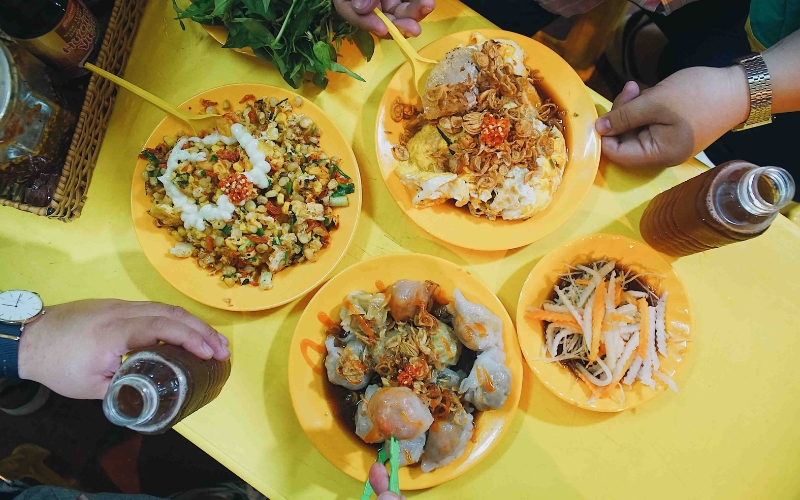
dumplings
Grilled Rice Paper
Often referred to as “Vietnamese pizza,” grilled rice paper is a crispy snack made from grilled rice paper topped with egg, dried shrimp, green onions, and chili sauce. The pancakes are grilled over charcoal, giving them a smoky flavor. For added flavor, vendors often top them with chili sauce, mayonnaise, or hoisin sauce, creating the perfect balance of salty, spicy, and slightly sweet. This popular street food is perfect for sharing and snacking while exploring the city. Try it from street vendors on Nguyen Van Cu Street or other bustling food courts.
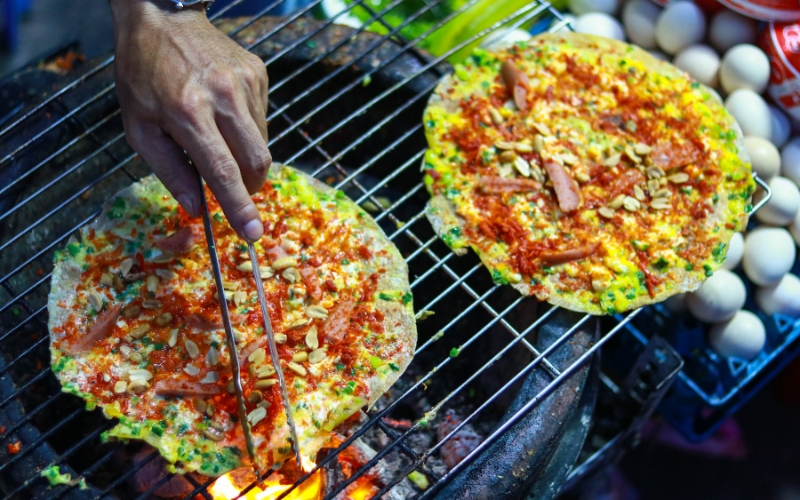
Vietnamese pizza, grilled rice paper
>>> Dive into the vibrant flavors of Saigon by exploring the must-try street foods that define this bustling city’s rich culinary scene.
Safety and Scams
While Ho Chi Minh City is generally a safe and friendly destination, it is important to be aware of potential safety concerns and scams to ensure a trouble-free trip. The most common problem tourists face is petty theft, including pickpockets and bag snatching, especially in crowded areas such as tourist attractions or when using public transport. Moped thieves often snatch phones or bags from pedestrians, so keep your belongings close, use a zipped crossbody bag, and avoid leaving valuables in public.
Scams are another problem, especially taxi and motorbike scams. To avoid overcharging or taking detours, use ride-hailing apps like Grab or Xanh SM for transparent pricing. In the markets, vendors may inflate prices or sell counterfeit goods, so bargaining is essential, but you can walk away if the price seems too high. Moreover, some restaurants and nightlife venues may add hidden fees or overcharge tourists, so always double-check the menu and bill before paying.
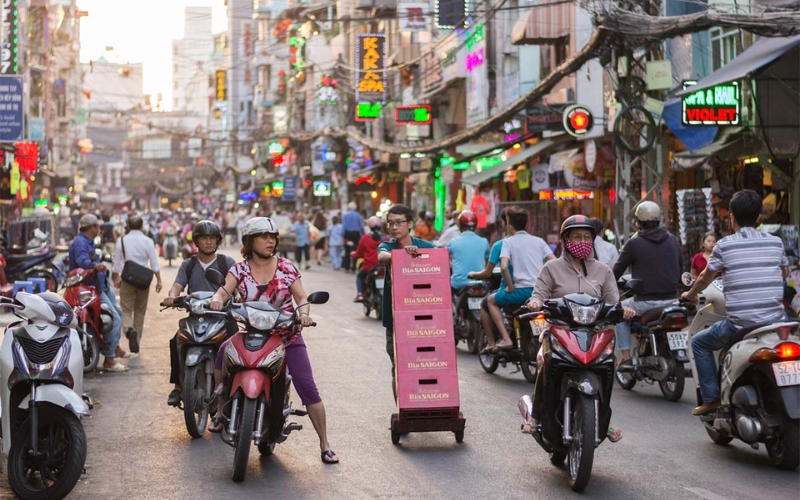
it is important to be aware of potential safety concerns and scams
Visiting Ho Chi Minh City is an exciting journey into the cultural, historical and vibrant heart of Vietnam. With its bustling streets, great food and rich heritage, the city offers endless opportunities for exploration. By understanding the important things to know before visiting Ho Chi Minh City, you will ensure a smoother and more memorable experience, allowing you to enjoy your trip to the fullest.
Read more:
